TOYOTA RAV4 PHEV 2021 Owners Manual
Manufacturer: TOYOTA, Model Year: 2021, Model line: RAV4 PHEV, Model: TOYOTA RAV4 PHEV 2021Pages: 666, PDF Size: 161.28 MB
Page 421 of 666
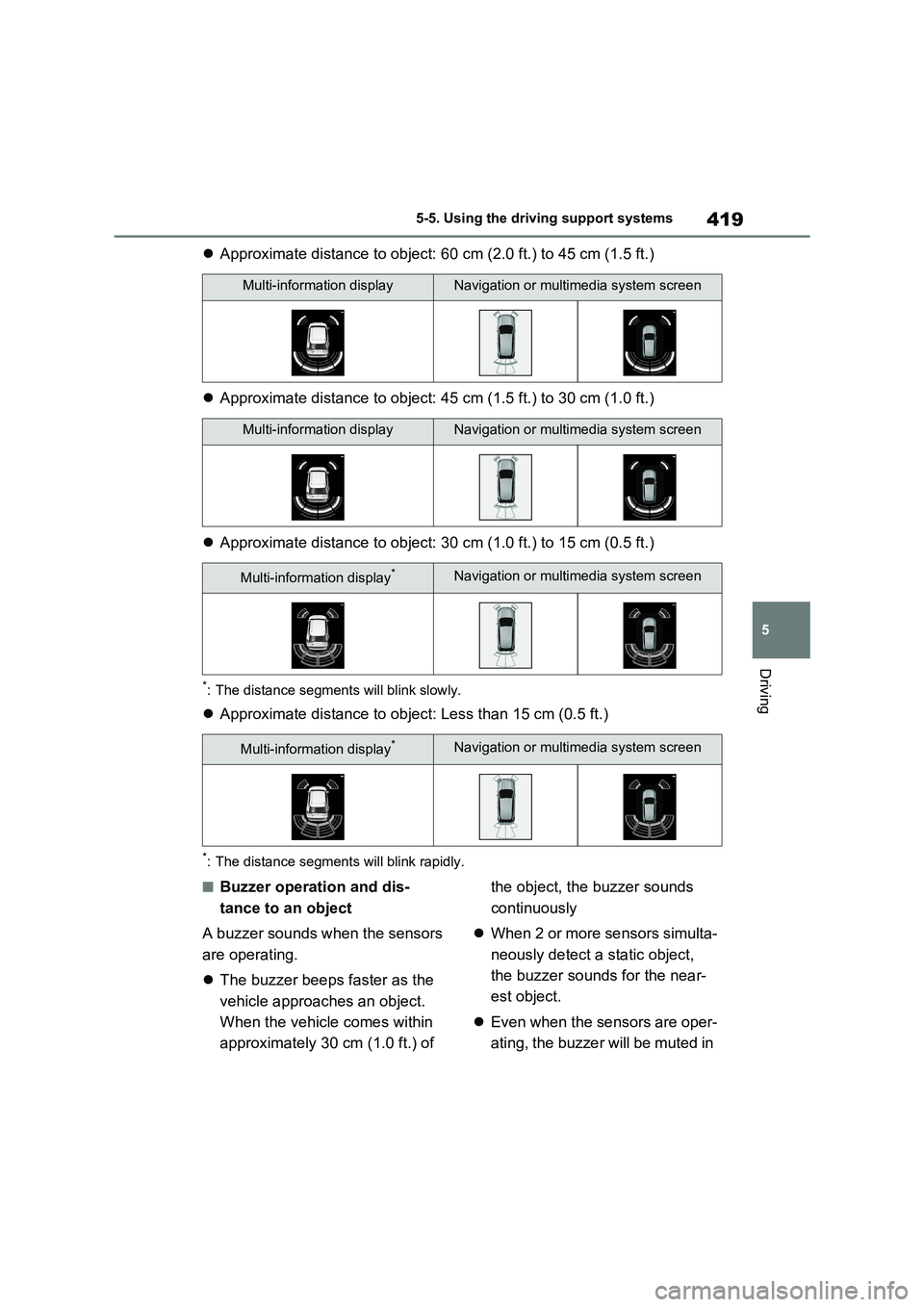
419
5
5-5. Using the driving support systems
Driving
Approximate distance to object: 60 cm (2.0 ft.) to 45 cm (1.5 ft.)
Approximate distance to object: 45 cm (1.5 ft.) to 30 cm (1.0 ft.)
Approximate distance to object: 30 cm (1.0 ft.) to 15 cm (0.5 ft.)
*: The distance segments will blink slowly.
Approximate distance to object: Less than 15 cm (0.5 ft.)
*: The distance segments will blink rapidly.
■Buzzer operation and dis-
tance to an object
A buzzer sounds when the sensors
are operating.
The buzzer beeps faster as the
vehicle approaches an object.
When the vehicle comes within
approximately 30 cm (1.0 ft.) of
the object, the buzzer sounds
continuously
When 2 or more sensors simulta-
neously detect a static object,
the buzzer sounds for the near -
est object.
Even when the sensors are oper-
ating, the buzze r will be muted in
Multi-information displayNavigation or multimedia system screen
Multi-information displayNavigation or multimedia system screen
Multi-information display*Navigation or multimedia system screen
Multi-information display*Navigation or multimedia system screen
Page 422 of 666
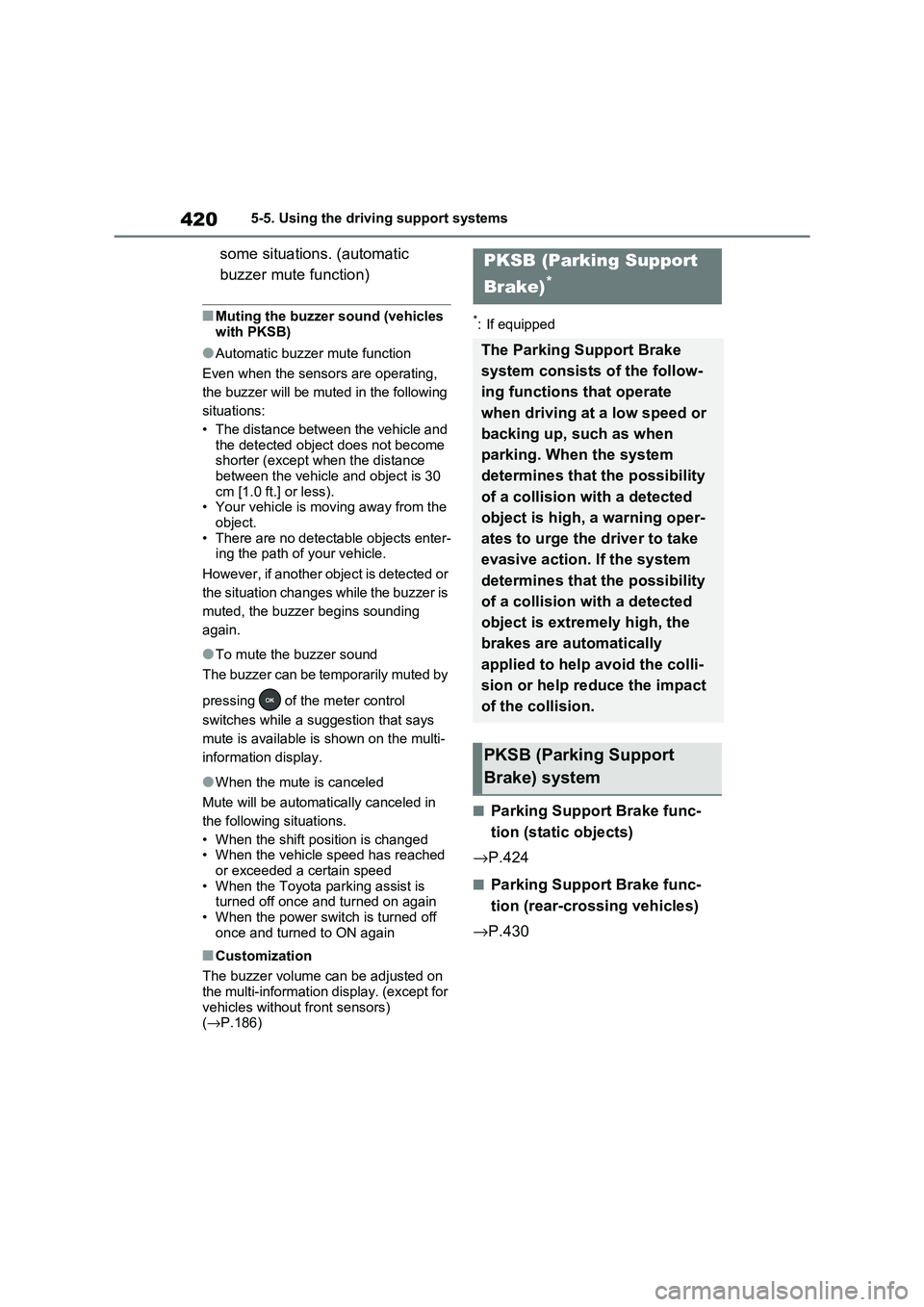
4205-5. Using the driving support systems
some situations. (automatic
buzzer mute function)
■Muting the buzzer sound (vehicles
with PKSB)
●Automatic buzzer mute function
Even when the sensor s are operating,
the buzzer will be muted in the following
situations:
• The distance between the vehicle and the detected objec t does not become
shorter (except when the distance
between the vehicle and object is 30 cm [1.0 ft.] or less).
• Your vehicle is moving away from the
object. • There are no detec table objects enter-
ing the path of your vehicle.
However, if another object is detected or
the situation changes while the buzzer is
muted, the buzzer begins sounding
again.
●To mute the buzzer sound
The buzzer can be temporarily muted by
pressing of the meter control
switches while a suggestion that says
mute is available is shown on the multi-
information display.
●When the mute is canceled
Mute will be automatic ally canceled in
the following situations.
• When the shift position is changed • When the vehicle s peed has reached
or exceeded a certain speed
• When the Toyota par king assist is turned off once and turned on again
• When the power switch is turned off
once and turned to ON again
■Customization
The buzzer volume can be adjusted on
the multi-information display. (except for
vehicles without front sensors) ( →P.186)
*: If equipped
■Parking Support Brake func-
tion (static objects)
→ P.424
■Parking Support Brake func-
tion (rear-crossing vehicles)
→ P.430
PKSB (Parking Support
Brake)*
The Parking Support Brake
system consists of the follow -
ing functions that operate
when driving at a low speed or
backing up, such as when
parking. When the system
determines that the possibility
of a collision with a detected
object is high, a warning oper-
ates to urge the driver to take
evasive action. If the system
determines that the possibility
of a collision with a detected
object is extrem ely high, the
brakes are automatically
applied to help avoid the colli -
sion or help red uce the impact
of the collision.
PKSB (Parking Support
Brake) system
Page 423 of 666
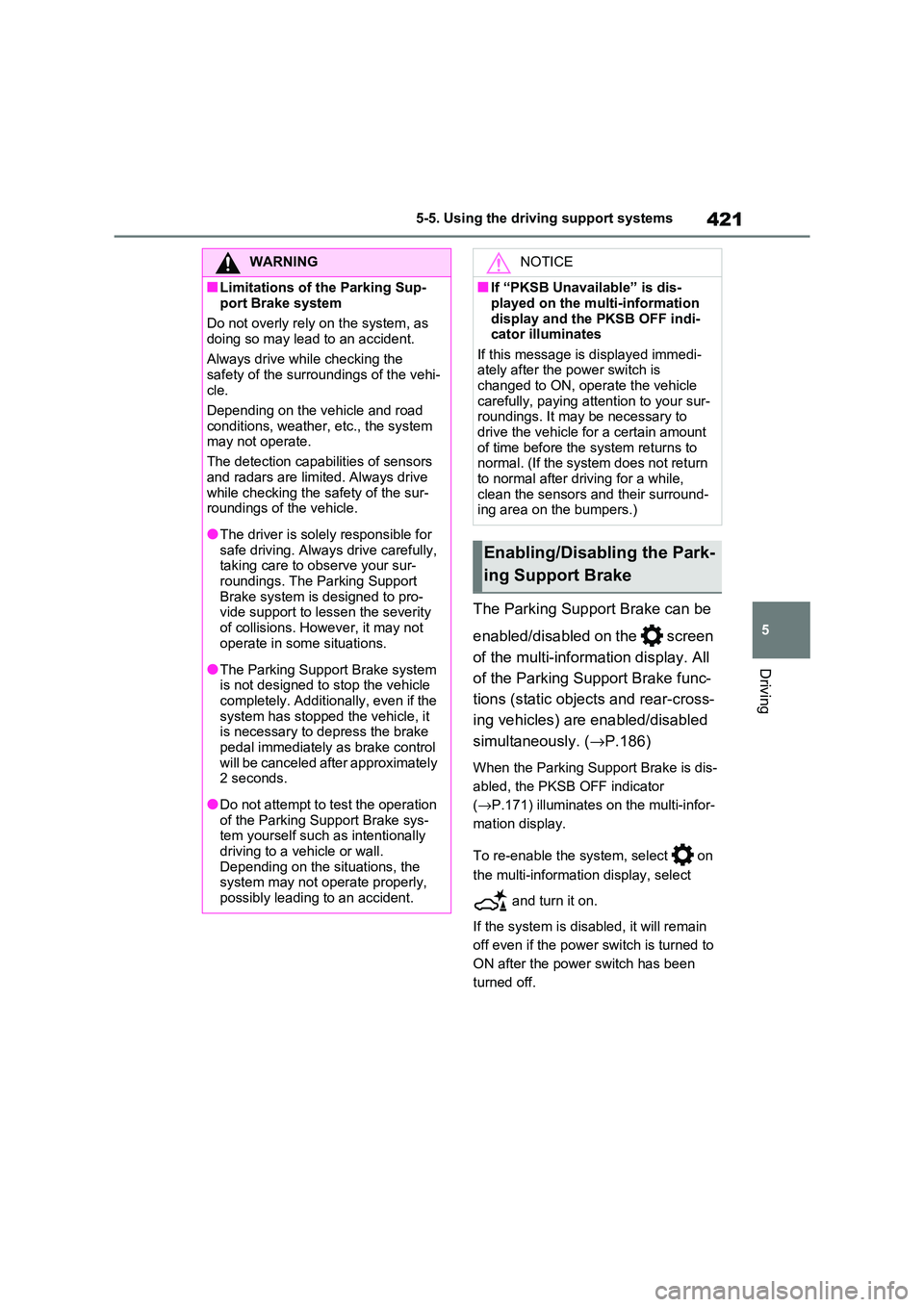
421
5
5-5. Using the driving support systems
Driving
The Parking Support Brake can be
enabled/disabled on the screen
of the multi-information display. All
of the Parking Support Brake func -
tions (static objects and rear-cross -
ing vehicles) are enabled/disabled
simultaneously. ( →P.186)
When the Parking Support Brake is dis-
abled, the PKSB OFF indicator
( →P.171) illuminates on the multi-infor-
mation display.
To re-enable the system, select on
the multi-information display, select
and turn it on.
If the system is disabl ed, it will remain
off even if the power switch is turned to
ON after the power switch has been
turned off.
WARNING
■Limitations of the Parking Sup -
port Brake system
Do not overly rely on the system, as doing so may lead to an accident.
Always drive while checking the
safety of the surroundings of the vehi - cle.
Depending on the v ehicle and road
conditions, weather, etc., the system
may not operate.
The detection capabilities of sensors
and radars are limited. Always drive
while checking the safety of the sur- roundings of the vehicle.
●The driver is solely responsible for safe driving. Always drive carefully,
taking care to observe your sur -
roundings. The Parking Support Brake system is designed to pro-
vide support to lessen the severity
of collisions. However, it may not operate in som e situations.
●The Parking Support Brake system is not designed to stop the vehicle
completely. Additionally, even if the
system has stopped the vehicle, it is necessary to depress the brake
pedal immediately as brake control
will be canceled after approximately 2 seconds.
●Do not attempt to test the operation of the Parking Support Brake sys -
tem yourself such as intentionally
driving to a vehicle or wall. Depending on the situations, the
system may not ope rate properly,
possibly leading to an accident.
NOTICE
■If “PKSB Unavailable” is dis -
played on the multi-information
display and the PKSB OFF indi - cator illuminates
If this message is displayed immedi -
ately after the power switch is changed to ON, ope rate the vehicle
carefully, paying attention to your sur -
roundings. It may be necessary to
drive the vehicle for a certain amount of time before the system returns to
normal. (If the syst em does not return
to normal after driving for a while, clean the sensors and their surround -
ing area on the bumpers.)
Enabling/Disabling the Park -
ing Support Brake
Page 424 of 666
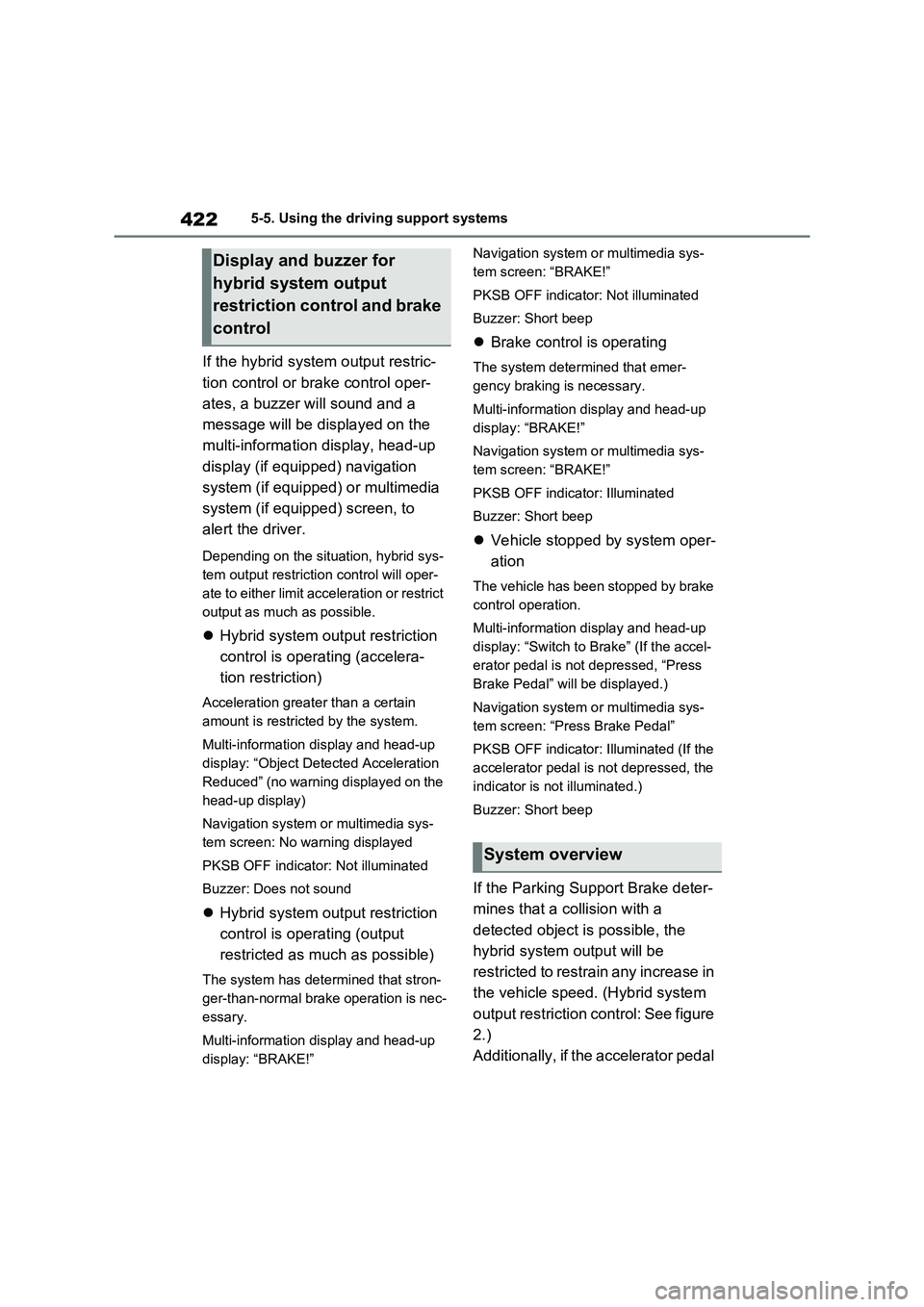
4225-5. Using the driving support systems
If the hybrid system output restric-
tion control or brake control oper -
ates, a buzzer will sound and a
message will be displayed on the
multi-information display, head-up
display (if equipped) navigation
system (if equipped) or multimedia
system (if equipped) screen, to
alert the driver.
Depending on the situation, hybrid sys -
tem output restricti on control will oper-
ate to either limit acceleration or restrict
output as much as possible.
Hybrid system output restriction
control is operating (accelera -
tion restriction)
Acceleration great er than a certain
amount is restrict ed by the system.
Multi-information display and head-up
display: “Object Det ected Acceleration
Reduced” (no warning displayed on the
head-up display)
Navigation system or multimedia sys -
tem screen: No warning displayed
PKSB OFF indicator: Not illuminated
Buzzer: Does not sound
Hybrid system output restriction
control is operating (output
restricted as much as possible)
The system has det ermined that stron-
ger-than-normal brake operation is nec -
essary.
Multi-information display and head-up
display: “BRAKE!”
Navigation system o r multimedia sys-
tem screen: “BRAKE!”
PKSB OFF indicator: Not illuminated
Buzzer: Short beep
Brake control is operating
The system determined that emer-
gency braking is necessary.
Multi-information display and head-up
display: “BRAKE!”
Navigation system o r multimedia sys-
tem screen: “BRAKE!”
PKSB OFF indicato r: Illuminated
Buzzer: Short beep
Vehicle stopped by system oper-
ation
The vehicle has been stopped by brake
control operation.
Multi-information display and head-up
display: “Switch to Brake” (If the accel -
erator pedal is not depressed, “Press
Brake Pedal” will be displayed.)
Navigation system o r multimedia sys-
tem screen: “Press Brake Pedal”
PKSB OFF indicato r: Illuminated (If the
accelerator pedal is not depressed, the
indicator is not illuminated.)
Buzzer: Short beep
If the Parking Support Brake deter -
mines that a collision with a
detected object is possible, the
hybrid system output will be
restricted to restrain any increase in
the vehicle speed. (Hybrid system
output restriction control: See figure
2.)
Additionally, if the accelerator pedal
Display and buzzer for
hybrid system output
restriction control and brake
control
System overview
Page 425 of 666
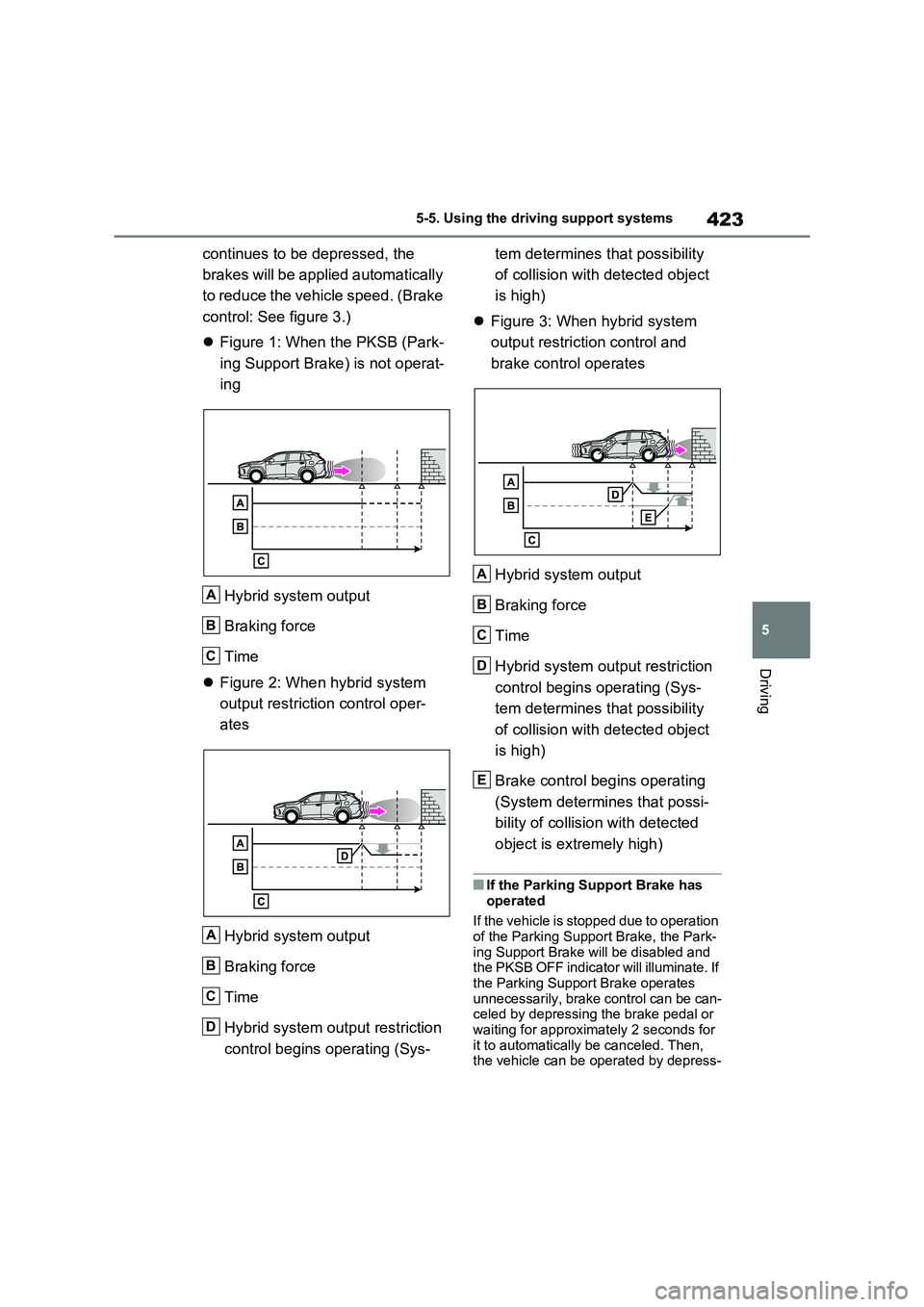
423
5
5-5. Using the driving support systems
Driving
continues to be depressed, the
brakes will be applied automatically
to reduce the vehicle speed. (Brake
control: See figure 3.)
Figure 1: When the PKSB (Park-
ing Support Brake) is not operat -
ing
Hybrid system output
Braking force
Time
Figure 2: When hybrid system
output restriction control oper -
ates
Hybrid system output
Braking force
Time
Hybrid system out put restriction
control begins operating (Sys -
tem determines that possibility
of collision with detected object
is high)
Figure 3: When hybrid system
output restriction control and
brake control operates
Hybrid system output
Braking force
Time
Hybrid system out put restriction
control begins operating (Sys -
tem determines that possibility
of collision with detected object
is high)
Brake control begins operating
(System determines that possi -
bility of collision with detected
object is extremely high)
■If the Parking Support Brake has
operated
If the vehicle is stopped due to operation
of the Parking Suppo rt Brake, the Park-
ing Support Brake will be disabled and the PKSB OFF indicator will illuminate. If
the Parking Support Brake operates
unnecessarily, brake control can be can - celed by depressing the brake pedal or
waiting for approximately 2 seconds for
it to automatically be canceled. Then, the vehicle can be operated by depress-
A
B
C
A
B
C
D
A
B
C
D
E
Page 426 of 666
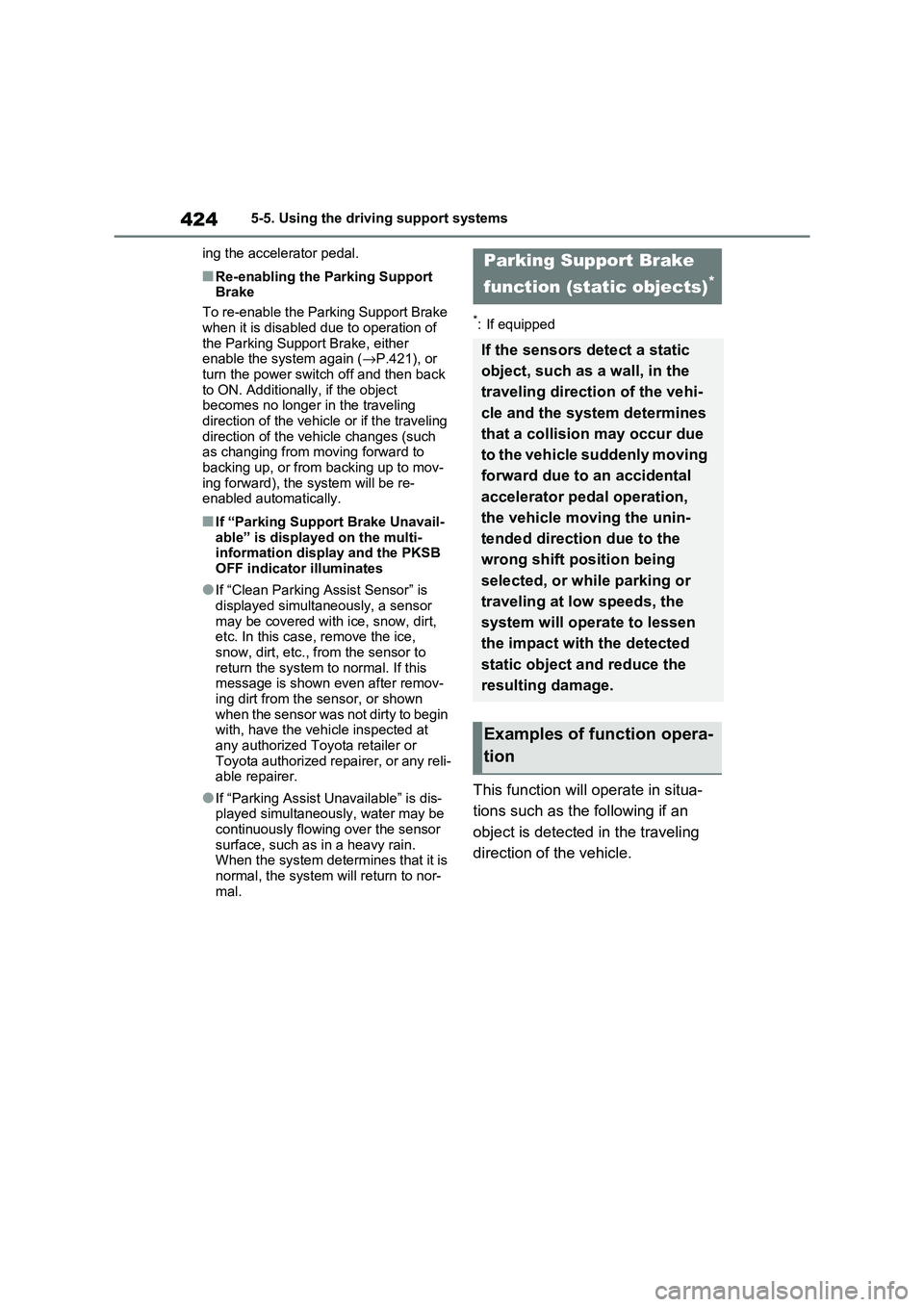
4245-5. Using the driving support systems
ing the accelerator pedal.
■Re-enabling the Parking Support
Brake
To re-enable the Parking Support Brake
when it is disabled due to operation of
the Parking Support Brake, either enable the system again ( →P.421), or
turn the power switch off and then back
to ON. Additionally, if the object becomes no longer in the traveling
direction of the vehicle or if the traveling
direction of the vehicle changes (such as changing from moving forward to
backing up, or from backing up to mov -
ing forward), the system will be re- enabled automatically.
■If “Parking Support Brake Unavail -
able” is displayed on the multi-
information display and the PKSB OFF indicator illuminates
●If “Clean Parking Assist Sensor” is displayed simultaneously, a sensor
may be covered with ice, snow, dirt,
etc. In this case, remove the ice, snow, dirt, etc., from the sensor to
return the system to normal. If this
message is shown even after remov - ing dirt from the sensor, or shown
when the sensor was not dirty to begin
with, have the vehi cle inspected at any authorized Toy ota retailer or
Toyota authorized repairer, or any reli -
able repairer.
●If “Parking Assist Unavailable” is dis -
played simultaneously, water may be continuously flowing over the sensor
surface, such as in a heavy rain.
When the system determines that it is normal, the system w ill return to nor-
mal.
*: If equipped
This function will operate in situa -
tions such as the following if an
object is detected in the traveling
direction of the vehicle.
Parking Support Brake
function (static objects)*
If the sensors detect a static
object, such as a wall, in the
traveling direction of the vehi -
cle and the system determines
that a collision may occur due
to the vehicle suddenly moving
forward due to an accidental
accelerator pedal operation,
the vehicle moving the unin -
tended direction due to the
wrong shift position being
selected, or while parking or
traveling at low speeds, the
system will operate to lessen
the impact with the detected
static object and reduce the
resulting damage.
Examples of function opera -
tion
Page 427 of 666
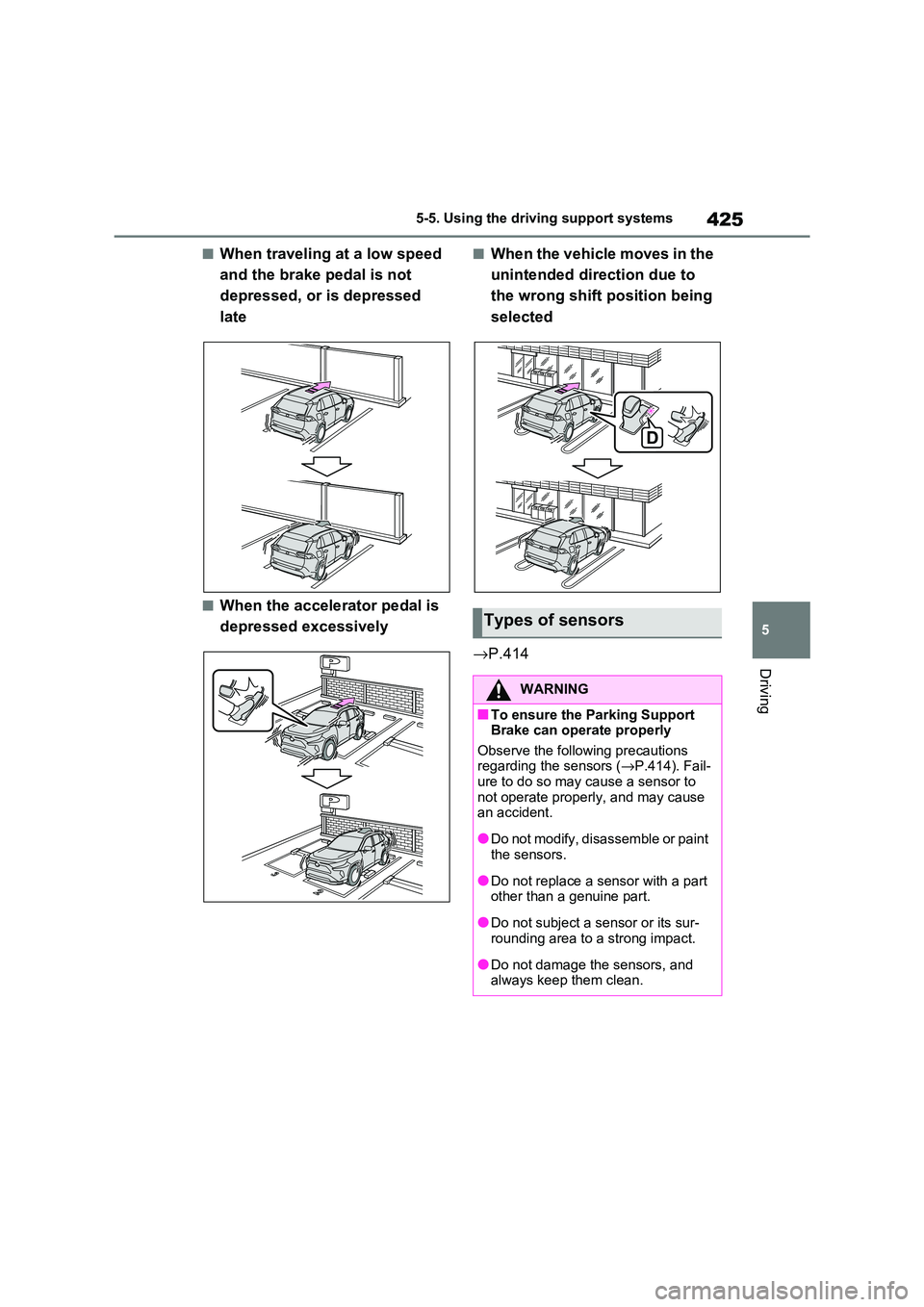
425
5
5-5. Using the driving support systems
Driving
■When traveling at a low speed
and the brake pedal is not
depressed, or is depressed
late
■When the accelerator pedal is
depressed excessively
■When the vehicle moves in the
unintended direction due to
the wrong shift position being
selected
→ P.414
Types of sensors
WARNING
■To ensure the Parking Support
Brake can operate properly
Observe the following precautions regarding the sensors ( →P.414). Fail-
ure to do so may cause a sensor to
not operate proper ly, and may cause an accident.
●Do not modify, disassemble or paint the sensors.
●Do not replace a s ensor with a part other than a genuine part.
●Do not subject a sensor or its sur - rounding area to a strong impact.
●Do not damage the sensors, and always keep them clean.
Page 428 of 666
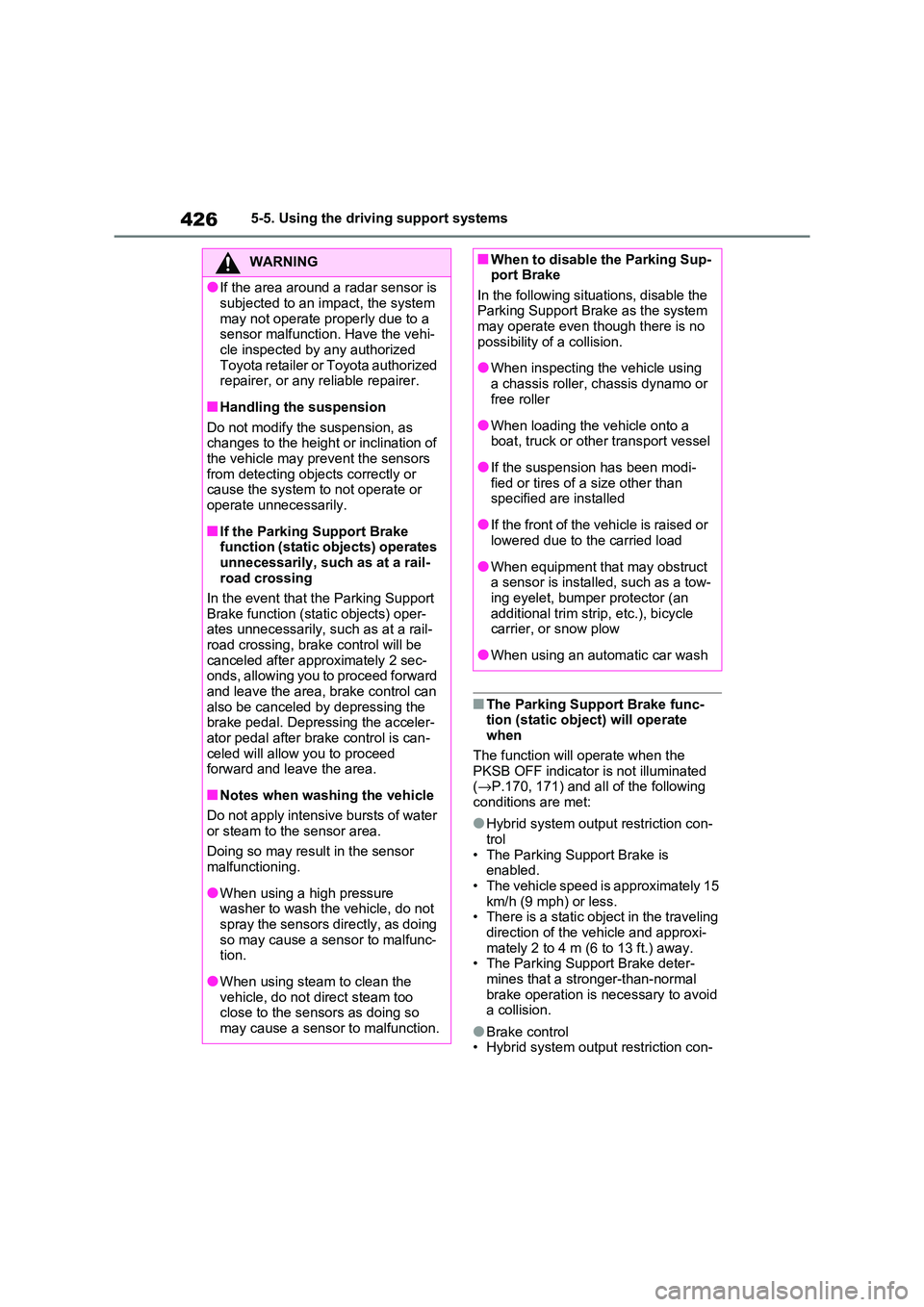
4265-5. Using the driving support systems
■The Parking Support Brake func- tion (static object) will operate
when
The function will operate when the
PKSB OFF indicator is not illuminated ( →P.170, 171) and all of the following
conditions are met:
●Hybrid system outpu t restriction con-
trol
• The Parking Support Brake is enabled.
• The vehicle speed is approximately 15
km/h (9 mph) or less. • There is a static object in the traveling
direction of the v ehicle and approxi-
mately 2 to 4 m (6 to 13 ft.) away. • The Parking Support Brake deter -
mines that a stronger-than-normal
brake operation is n ecessary to avoid a collision.
●Brake control• Hybrid system outpu t restriction con-
WARNING
●If the area around a radar sensor is
subjected to an im pact, the system
may not operate properly due to a sensor malfunction. Have the vehi -
cle inspected by any authorized
Toyota retailer or Toyota authorized repairer, or any reliable repairer.
■Handling the suspension
Do not modify the suspension, as changes to the height or inclination of
the vehicle may pr event the sensors
from detecting objects correctly or cause the system to not operate or
operate unnecessarily.
■If the Parking Support Brake
function (static objects) operates
unnecessarily, such as at a rail - road crossing
In the event that the Parking Support
Brake function (sta tic objects) oper- ates unnecessarily, such as at a rail-
road crossing, brake control will be
canceled after appr oximately 2 sec- onds, allowing you to proceed forward
and leave the area, brake control can
also be canceled by depressing the brake pedal. Depressing the acceler -
ator pedal after brake control is can -
celed will allow you to proceed forward and leav e the area.
■Notes when washing the vehicle
Do not apply intensive bursts of water
or steam to the sensor area.
Doing so may resul t in the sensor malfunctioning.
●When using a high pressure washer to wash the vehicle, do not
spray the sensors directly, as doing
so may cause a sensor to malfunc - tion.
●When using steam to clean the vehicle, do not direct steam too
close to the sensors as doing so
may cause a sensor to malfunction.
■When to disable the Parking Sup - port Brake
In the following situations, disable the
Parking Support Brake as the system may operate even t hough there is no
possibility of a collision.
●When inspecting t he vehicle using
a chassis roller, chassis dynamo or
free roller
●When loading the vehicle onto a
boat, truck or other transport vessel
●If the suspension has been modi -
fied or tires of a size other than specified are installed
●If the front of the vehicle is raised or lowered due to the carried load
●When equipment that may obstruct a sensor is instal led, such as a tow-
ing eyelet, bumper protector (an
additional trim st rip, etc.), bicycle carrier, or snow plow
●When using an autom atic car wash
Page 429 of 666
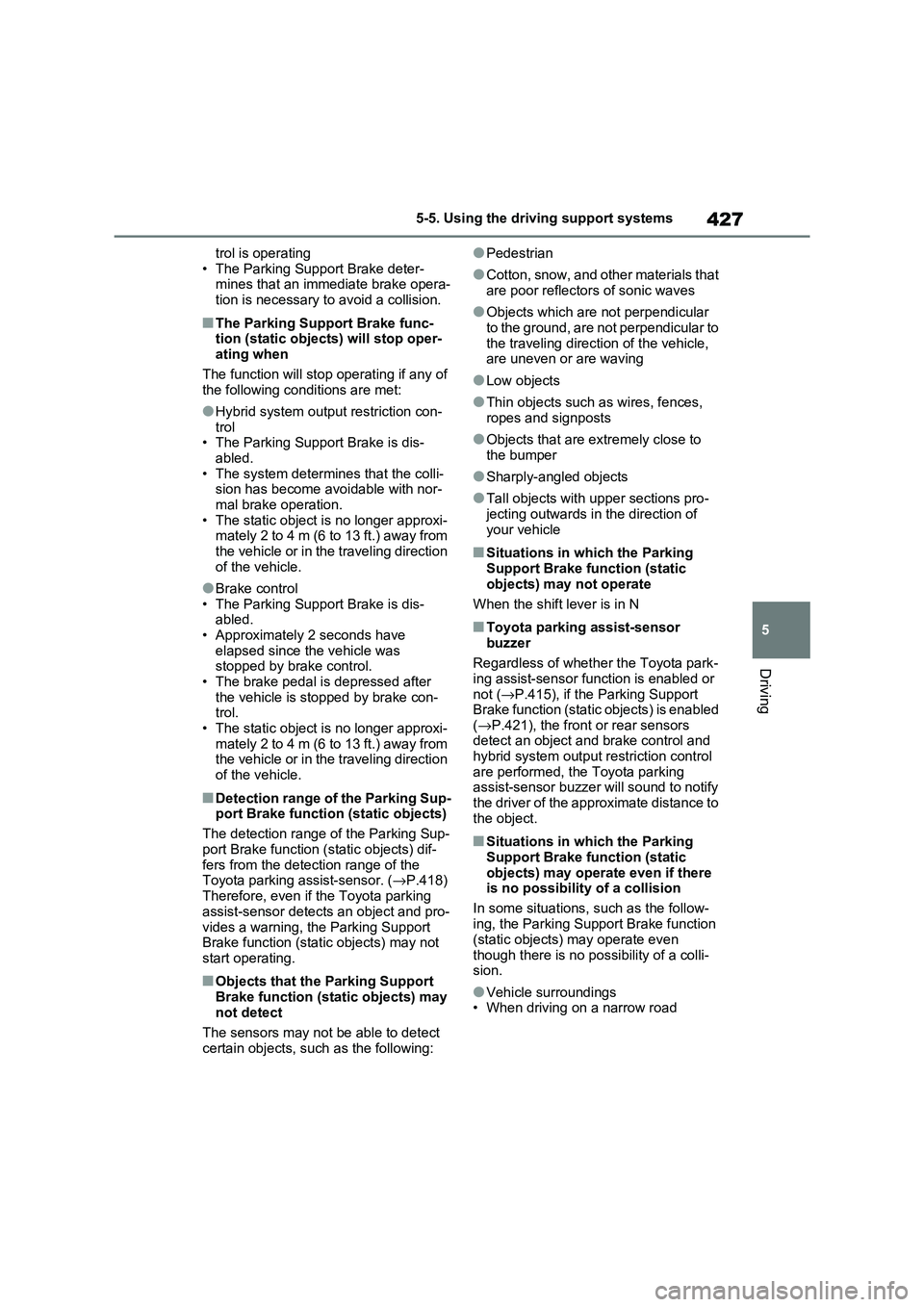
427
5
5-5. Using the driving support systems
Driving
trol is operating
• The Parking Support Brake deter - mines that an imm ediate brake opera-
tion is necessary t o avoid a collision.
■The Parking Support Brake func-
tion (static objects) will stop oper - ating when
The function will stop operating if any of
the following conditions are met:
●Hybrid system output restriction con -
trol • The Parking Support Brake is dis -
abled.
• The system determine s that the colli- sion has become avoidable with nor-
mal brake operation.
• The static object is no longer approxi - mately 2 to 4 m (6 to 13 ft.) away from
the vehicle or in the traveling direction
of the vehicle.
●Brake control
• The Parking Support Brake is dis - abled.
• Approximately 2 seconds have
elapsed since the vehicle was stopped by brake control.
• The brake pedal is depressed after
the vehicle is stopped by brake con - trol.
• The static object is no longer approxi -
mately 2 to 4 m (6 to 13 ft.) away from the vehicle or in the traveling direction
of the vehicle.
■Detection range of the Parking Sup -
port Brake function (static objects)
The detection range of the Parking Sup -
port Brake function ( static objects) dif-
fers from the detection range of the Toyota parking assist-sensor. ( →P.418)
Therefore, even if the Toyota parking
assist-sensor detect s an object and pro-
vides a warning, the Parking Support Brake function (static objects) may not
start operating.
■Objects that the Parking Support
Brake function (static objects) may not detect
The sensors may not be able to detect
certain objects, such as the following:
●Pedestrian
●Cotton, snow, and other materials that
are poor reflectors of sonic waves
●Objects which are not perpendicular
to the ground, are not perpendicular to
the traveling direction of the vehicle, are uneven or are waving
●Low objects
●Thin objects such as wires, fences,
ropes and signposts
●Objects that are e xtremely close to
the bumper
●Sharply-angled objects
●Tall objects with upper sections pro-
jecting outwards in the direction of
your vehicle
■Situations in which the Parking Support Brake function (static
objects) may not operate
When the shift lever is in N
■Toyota parking assist-sensor buzzer
Regardless of whether the Toyota park -
ing assist-sensor function is enabled or not ( →P.415), if the Parking Support
Brake function (static objects) is enabled
( →P.421), the front or rear sensors detect an object and brake control and
hybrid system output r estriction control
are performed, the Toyota parking assist-sensor buzzer will sound to notify
the driver of the approximate distance to
the object.
■Situations in which the Parking Support Brake function (static
objects) may operate even if there
is no possibility of a collision
In some situations, s uch as the follow-
ing, the Parking Support Brake function
(static objects) may operate even
though there is no possibility of a colli - sion.
●Vehicle surroundings• When driving on a narrow road
Page 430 of 666
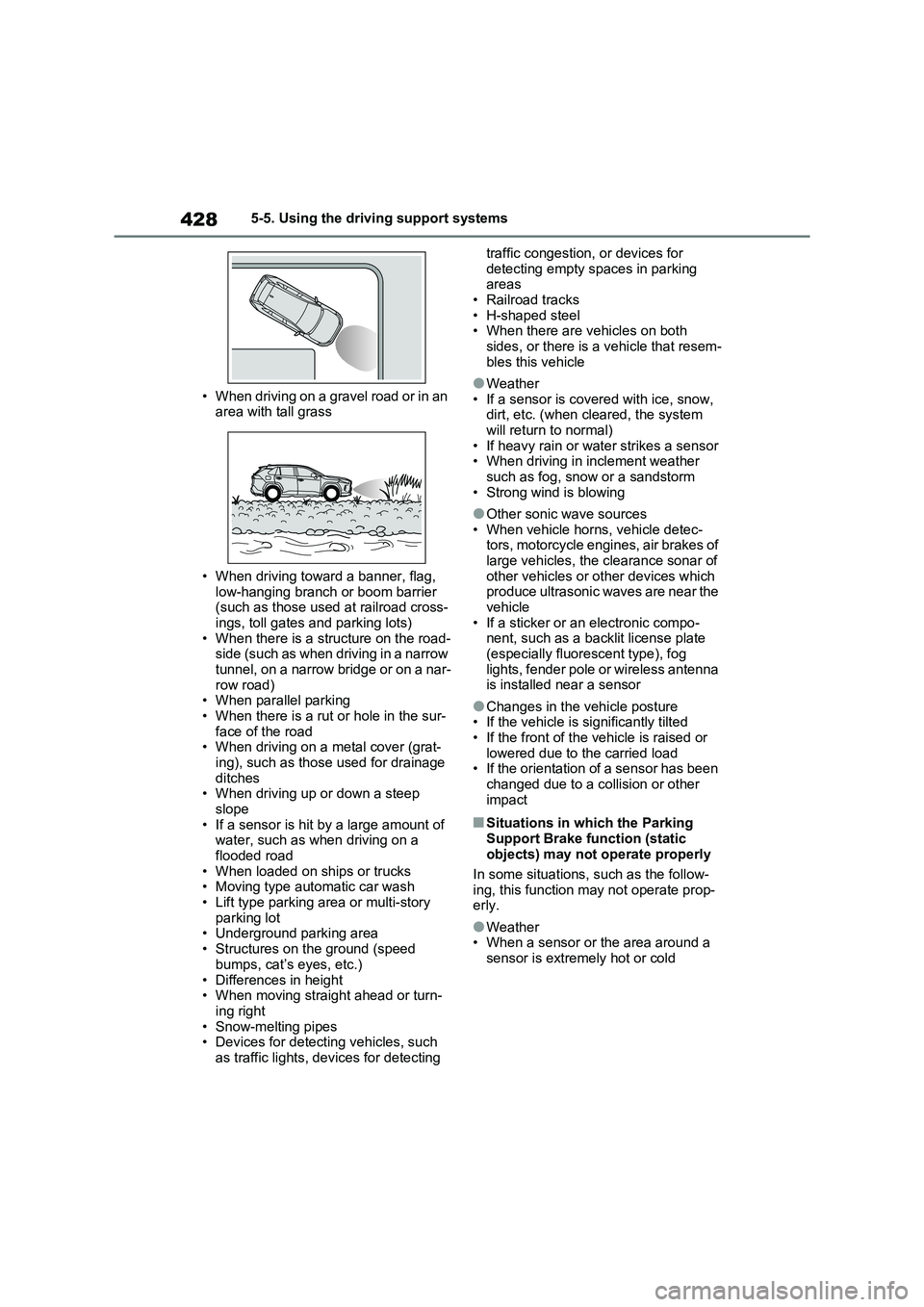
4285-5. Using the driving support systems
• When driving on a gravel road or in an
area with tall grass
• When driving toward a banner, flag,
low-hanging branch or boom barrier (such as those used at railroad cross-
ings, toll gates and parking lots)
• When there is a structure on the road - side (such as when driving in a narrow
tunnel, on a narrow bridge or on a nar -
row road) • When parallel parking
• When there is a rut o r hole in the sur-
face of the road • When driving on a metal cover (grat -
ing), such as those used for drainage
ditches • When driving up or down a steep
slope
• If a sensor is hit by a large amount of water, such as when driving on a
flooded road
• When loaded on ships or trucks • Moving type automatic car wash
• Lift type parking area or multi-story
parking lot • Underground parking area
• Structures on the ground (speed
bumps, cat’s eyes, etc.)
• Differences in height • When moving straight ahead or turn -
ing right
• Snow-melting pipes • Devices for detecting vehicles, such
as traffic lights, dev ices for detecting
traffic congestion, or devices for
detecting empty spaces in parking areas
• Railroad tracks
• H-shaped steel • When there are vehicles on both
sides, or there is a vehicle that resem -
bles this vehicle
●Weather
• If a sensor is covered with ice, snow, dirt, etc. (when c leared, the system
will return to normal)
• If heavy rain or water strikes a sensor • When driving in inclement weather
such as fog, snow or a sandstorm
• Strong wind is blowing
●Other sonic wave sources
• When vehicle horns, vehicle detec - tors, motorcycle engines, air brakes of
large vehicles, the clearance sonar of
other vehicles or other devices which produce ultrasonic waves are near the
vehicle
• If a sticker or an electronic compo - nent, such as a backlit license plate
(especially fluorescent type), fog
lights, fender pole or wireless antenna is installed near a sensor
●Changes in the vehicle posture• If the vehicle is significantly tilted
• If the front of the v ehicle is raised or
lowered due to the carried load • If the orientation of a sensor has been
changed due to a collision or other
impact
■Situations in which the Parking Support Brake function (static
objects) may not operate properly
In some situations, s uch as the follow- ing, this function m ay not operate prop-
erly.
●Weather • When a sensor or the area around a
sensor is extremely hot or cold